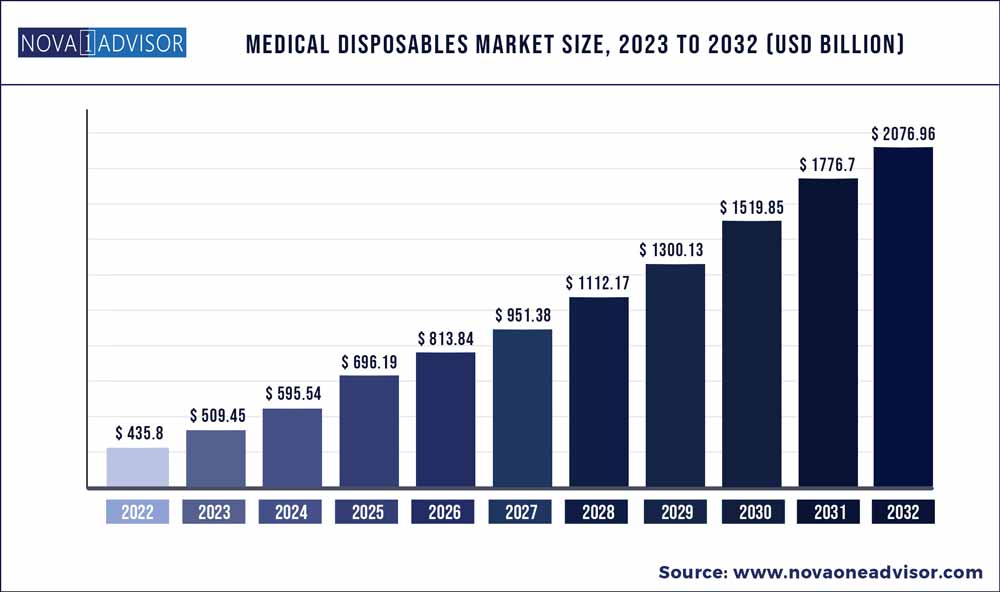The global medical disposables market size was exhibited at USD 435.8 billion in 2022 and is projected to hit around USD 2,076.96 billion by 2032, growing at a CAGR of 16.7% during the forecast period 2023 to 2032.

Key Pointers:
- The sterilization supplies segment dominated the market for medical disposables and held the largest revenue share of over 19.0% in 2022.
- The plastic resins segment dominated the market and accounted for the largest revenue share of over 70.0% in 2022.
- The hospital segment dominated the market and held the largest revenue share of 62.0% in 2022.
- North America dominated the market and held the largest revenue share of 40.3% in 2022
- The Asia Pacific, the market is expected to witness the fastest growth over the forecast period
Medical Disposables Market Report Scope
| Report Coverage |
Details |
| Market Size in 2023 |
USD 509.45 Billion |
| Market Size by 2032 |
USD 2,076.96 Billion |
| Growth Rate From 2023 to 2032 |
CAGR of 16.9% |
| Base Year |
2022 |
| Forecast Period |
2023 to 2032 |
| Segments Covered |
Product, Raw material, End-use |
| Companies Mentioned |
Medline Industries, Inc.; Smith & Nephew PLC; Bayer AG; BD; 3M; Cardinal Health |
| Regions Covered |
North America; Europe; Asia Pacific; Latin America; MEA |
The growth of the market is attributable to the increasing number of surgical procedures, rising incidence of Hospital Acquired Infections (HAIs), growing prevalence of chronic diseases leading to longer hospital admission, and the impact of COVID-19 outbreaks across the globe.
The COVID-19 outbreak and increasing hospital admissions across the globe have significantly increased the demand for medical disposables. The WHO has appealed to industries and governments to increase the manufacturing of personal protective equipment, including hospital gowns, gloves, medical masks, face shields, aprons, respirators, and goggles, by 40.00% to meet the increasing global demand. It also reported that the increase in demand for these accessories has increased their prices to a major extent. For instance, the price of surgical masks has increased six-fold and the price of hospital gowns has increased two-fold. Furthermore, the WHO has shipped around half a million sets of personal protective equipment to around 47 countries. Therefore, the outbreak of COVID-19 has immensely impacted the market and is a highly effective driver for this market.
The outbreak of COVID-19 is anticipated to significantly impact the market for medical disposables. The pandemic caused by the virus SARS-CoV-2 has drastically increased the demand for medicines, medical disposable products, emergency supplies, and hospital equipment including gowns, antiseptics, and disinfectant products. COVID-19 is a zoonotic virus and bats were considered to be the key reservoir of the virus. In December 2019, the first patient was reported in China and since then, the disease has spread at a rapid pace. The first case was reported in Wuhan and has been identified that the infection was acquired from a zoonotic source. Post that incident human-to-human transmission of the virus largely took place in families within Wuhan.
Increasing number of surgeries globally is a key factor expected to drive the market over the forecast period. For instance, as per Mölnlycke Health Care AB, 70.00 million surgical procedures are performed every year in Europe. As such, medical disposable products such as hospital gowns, disposables eye gear, hand sanitizers, respiratory supplies, and sterilization supplies, which are being an essential requirement for surgical procedures, are expected to witness high demand over the forecast period. For instance, as per the report published by the Organization for Economic Co-operation and Development (OECD), around 390,352 surgeries were performed in Canada in 2017. Disposable products prevent the transmission of nosocomial infections to some extent owing to which surgeons consistently prefer to use disposable products over the reusable ones. Such factors are expected to boost market growth.
Increasing incidence of HAIs due to lack of sanitation and precaution is also one of the leading factors contributing to the market growth. For instance, as per the CDC, about one in 25 hospital patients contracts at least one HAI every year. Non-woven disposables such as hospital gowns provide general protection against contamination and can help to lower the risk of contracting HAIs. Furthermore, they can prevent bacterial and other microbial infections from entering a patient’s body. Thus, surgeons recommend patients to wear disposable gowns before medical procedures. These factors are anticipated to propel the market growth over the forecast period.
Some of the prominent players in the Medical disposables Market include:
- Medline Industries, Inc.
- Smith & Nephew PLC
- Bayer AG
- BD
- 3M
- Cardinal Health
Segments Covered in the Report
This report forecasts revenue growth at global, regional, and country levels and provides an analysis of the latest industry trends in each of the sub-segments from 2018 to 2032. For this study, Nova one advisor, Inc. has segmented the global medical disposables market.
By Product
- Wound Management Products
- Drug Delivery Products
- Diagnostic and Laboratory Disposables
- Dialysis Disposables
- Incontinence Products
- Respiratory Supplies
- Sterilization Supplies
- Non-woven Disposables
- Disposable Masks
- Disposable Eye Gear
- Disposable Gloves
- Hand Sanitizers
- Gel Sanitizers
- Foam Sanitizers
- Liquid Sanitizers
- Other Sanitizers
- Others
By Raw Material
- Plastic Resin
- Nonwoven Material
- Rubber
- Paper and Paperboard
- Metals
- Glass
- Others
By End-use
- Hospitals
- Home Healthcare
- Outpatient/Primary Care Facilities
- Others
By Region
- North America
- Europe
- Asia-Pacific
- Latin America
- Middle East & Africa (MEA)

